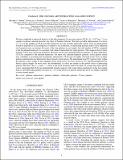ChAInGeS: THE CHANDRA ARP INTERACTING GALAXIES SURVEY
Author(s)
Smith, Beverly J.; Swartz, Douglas A.; Miller, Olivia; Burleson, Jacob A.; Nowak, Michael A.; Struck, Curtis; ... Show more Show less
DownloadSmith-2012-ChAInGeS_ THE CHANDR.pdf (982.1Kb)
PUBLISHER_POLICY
Publisher Policy
Article is made available in accordance with the publisher's policy and may be subject to US copyright law. Please refer to the publisher's site for terms of use.
Terms of use
Metadata
Show full item recordAbstract
We have conducted a statistical analysis of the ultra-luminous X-ray point sources (ULXs; LX ≥ 10[superscript 39] erg s–1) in a sample of galaxies selected from the Arp Atlas of Peculiar Galaxies. We find a possible enhancement of a factor of ~2-4 in the number of ULXs per blue luminosity for the strongly interacting subset. Such an enhancement would be expected if ULX production is related to star formation, as interacting galaxies tend to have enhanced star formation rates on average. For most of the Arp galaxies in our sample, the total number of ULXs compared to the far-infrared luminosity is consistent with values found earlier for spiral galaxies. This suggests that for these galaxies, ULXs trace recent star formation. However, for the most infrared-luminous galaxies, we find a deficiency of ULXs compared to the infrared luminosity. For these very infrared-luminous galaxies, active galactic nuclei may contribute to powering the far-infrared; alternatively, ULXs may be highly obscured in the X-ray in these galaxies and therefore not detected by these Chandra observations. We determined local UV/optical colors within the galaxies in the vicinity of the candidate ULXs using Galaxy Evolution Explorer UV and Sloan Digitized Sky Survey optical images. In most cases, the distributions of colors are similar to the global colors of interacting galaxies. However, the u – g and r – i colors at the ULX locations tend to be bluer on average than these global colors, suggesting that ULXs are preferentially found in regions with young stellar populations. In the Arp sample there is a possible enhancement of a factor of ~2-5 in the fraction of galactic nuclei that are X-ray-bright compared to more normal spirals.
Date issued
2012-06Department
MIT Kavli Institute for Astrophysics and Space ResearchJournal
Astronomical Journal
Publisher
Institute of Physics/American Astronomical Society
Citation
Smith, Beverly J., Douglas A. Swartz, Olivia Miller, Jacob A. Burleson, Michael A. Nowak, and Curtis Struck. “ ChAInGeS: THE CHANDRA ARP INTERACTING GALAXIES SURVEY .” The Astronomical Journal 143, no. 6 (May 11, 2012): 144. ©2012 Royal Astronomical Society.
Version: Final published version
ISSN
0004-6256
1538-3881